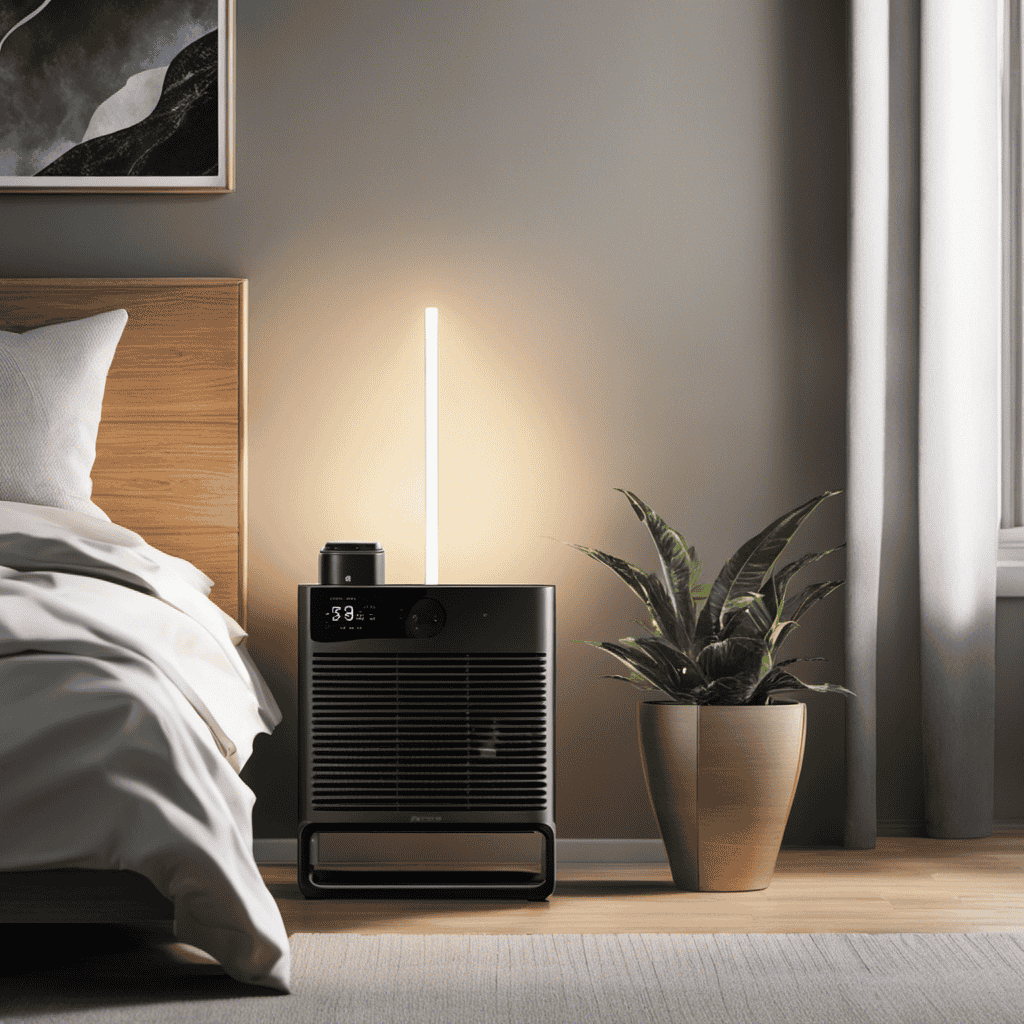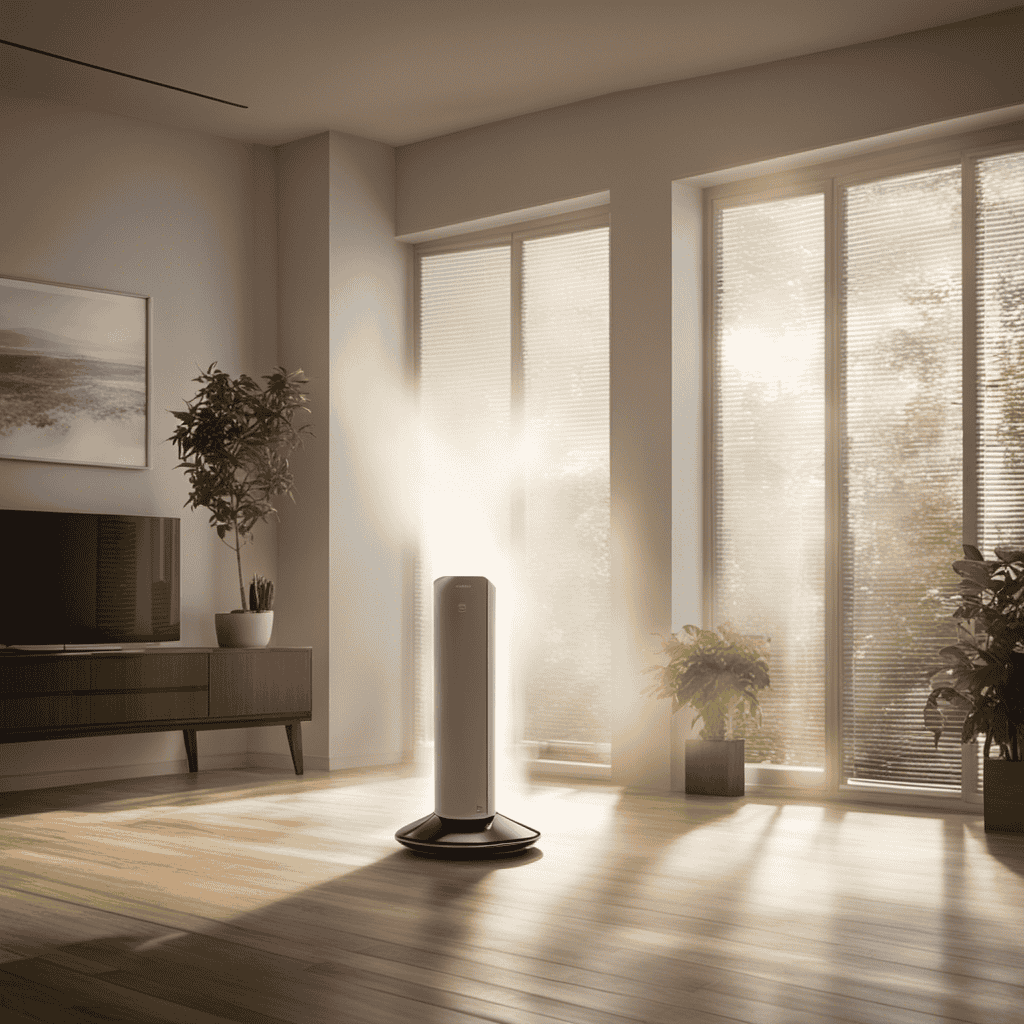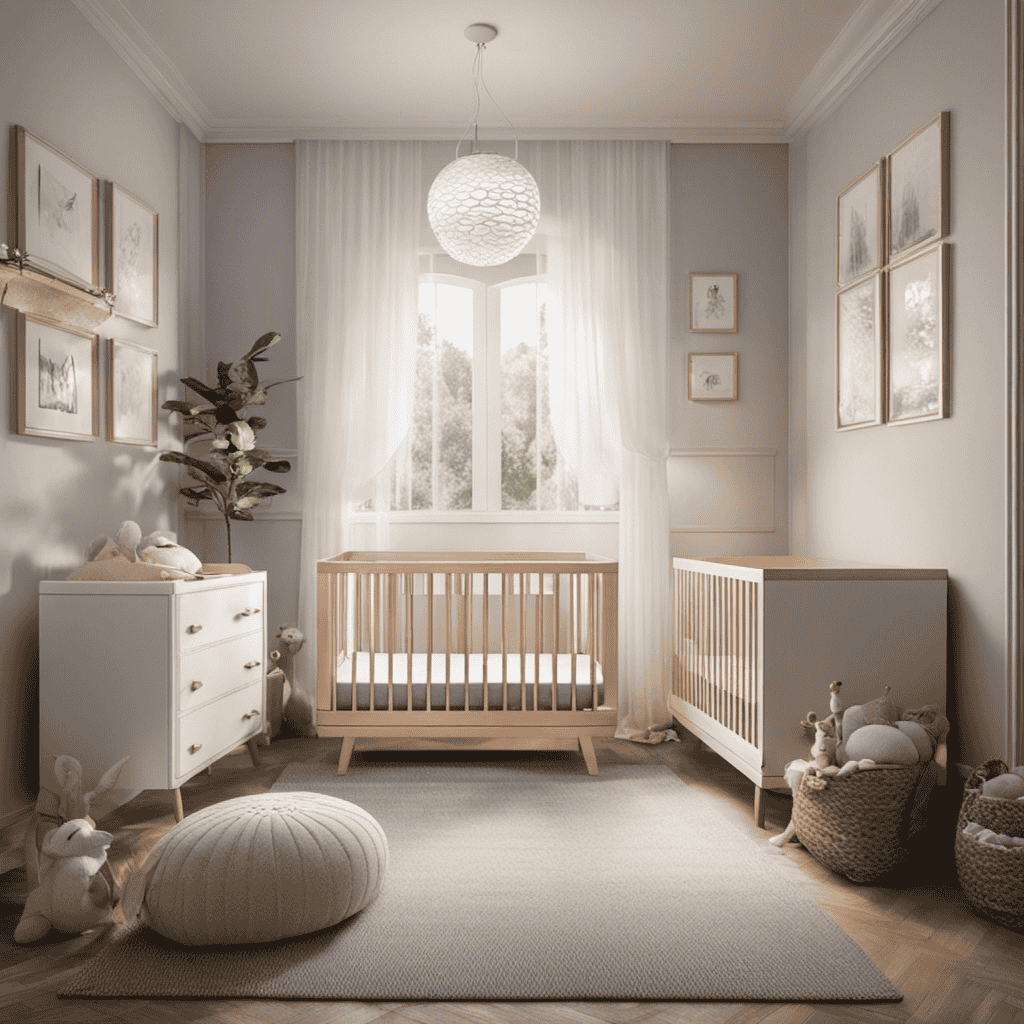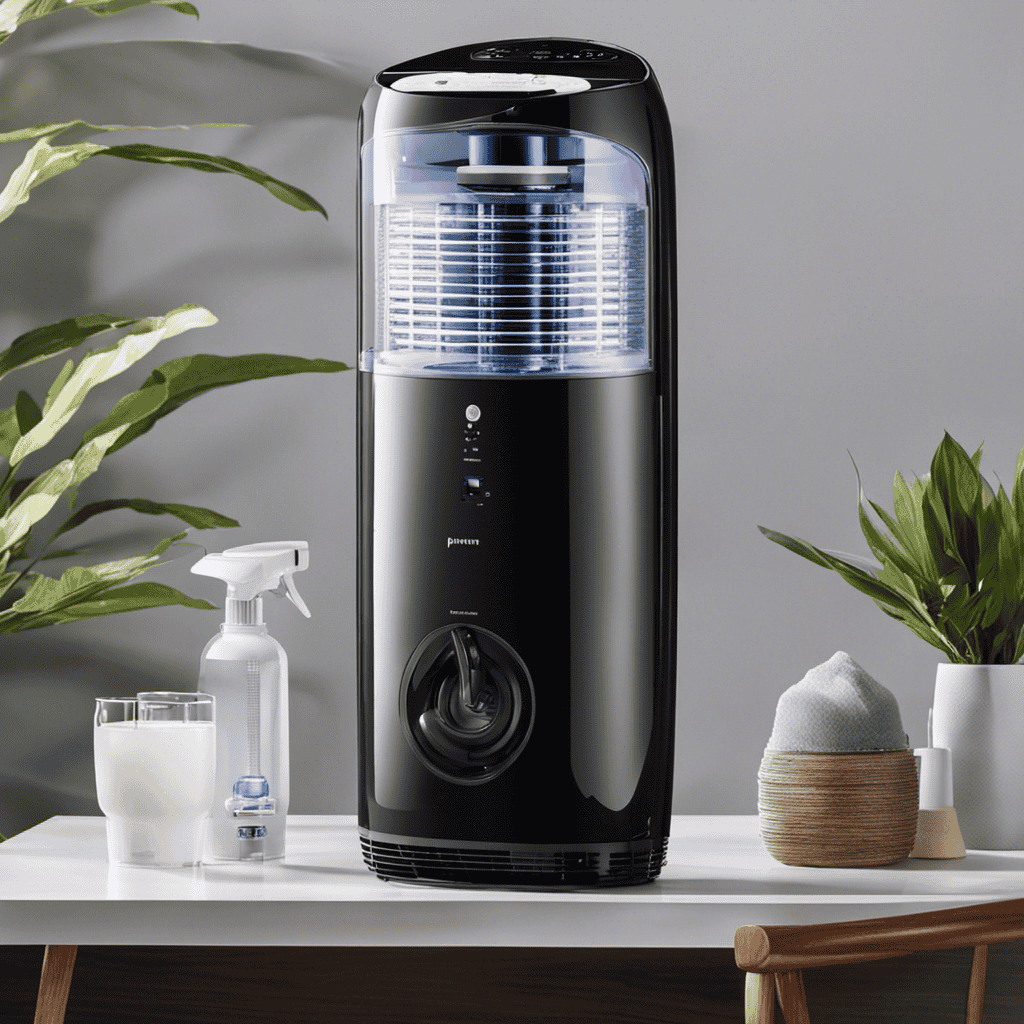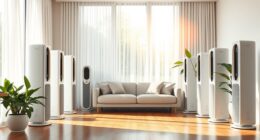As someone who is passionate about air quality, I have frequently pondered the best location to position my air purifier, akin to a detective on the hunt for the ideal spot. With numerous variables to take into account, it can feel daunting.
But fear not! In this article, I will guide you through the process of finding the ideal location for your air purifier. By evaluating the layout of your home, assessing air circulation and potential pollutant sources, and considering other important factors, you’ll be able to create a clean and healthy environment.
Key Takeaways
- Evaluate the layout of your home, including the size of each room and furniture arrangement, to determine the best placement for the air purifier.
- Consider the presence of indoor plants, the effectiveness of ventilation systems, and the airflow in each room when choosing the most suitable location for the air purifier.
- Place the air purifier in high foot traffic areas to reduce exposure to airborne contaminants and improve air quality in frequently passed areas.
- Ensure proper air circulation by avoiding furniture blockage and positioning furniture to maximize airflow in the room.
Consider the Layout of Your Home
You should consider the layout of your home when deciding where to place your air purifier. Evaluating the natural light in each room is an important factor to consider.
Natural light can help in reducing the growth of mold and mildew, which are common indoor pollutants. Rooms that receive ample natural light are generally a better choice for placing an air purifier as they tend to have better air quality.
Additionally, assessing the presence of indoor plants is crucial. While plants can help improve indoor air quality by removing pollutants, they can also release certain chemicals that may affect air quality. Therefore, it is important to evaluate the number and types of plants in each room before deciding on the placement of your air purifier.
Moving on to the next consideration, it is also essential to evaluate the air circulation in each room.
Evaluate the Air Circulation in Each Room
When it comes to ensuring clean and fresh air in your home, it is important to assess the effectiveness of ventilation. Proper ventilation plays a crucial role in removing indoor pollutants and improving air quality.
By evaluating the airflow and ventilation systems in each room, you can identify areas that may require additional measures to enhance air circulation.
Additionally, considering the layout of your rooms is essential in strategically placing air purifiers to optimize their performance and reach.
Assess Ventilation for Effectiveness
To effectively assess ventilation, consider how well air circulates in the room where you plan to place the air purifier. Assessing airflow and measuring air quality are crucial steps in determining the most suitable location for your purifier. Ventilation plays a significant role in the effectiveness of an air purifier, as it determines how efficiently the device can filter and circulate the air. To help you visualize this, let’s consider a simple table:
| Room Features | Assessment |
|---|---|
| Windows | Are they open or closed? |
| Doors | Are they frequently opened or closed? |
| Vents | Are they obstructed or clear? |
Consider Room Layout
Now that we’ve assessed ventilation, let’s take a look at how the room layout can impact air purification.
Room size and furniture arrangement play crucial roles in determining the effectiveness of an air purifier. The size of the room will determine the capacity and power needed for the air purifier to effectively clean the air. A larger room will require a more powerful unit to ensure proper air circulation and purification.
Furniture arrangement is also important as it can obstruct the airflow and hinder the performance of the air purifier. It is recommended to place the air purifier in a central location with minimal obstructions to ensure optimal air purification.
By considering the room size and furniture arrangement, you can ensure that your air purifier works efficiently to improve the air quality in your space.
Now let’s assess the proximity to potential pollutant sources for further analysis.
Assess the Proximity to Potential Pollutant Sources
When considering the placement of an air purifier, it’s crucial to assess the proximity to potential pollutant sources. Nearby pollutant hotspots, such as industrial areas or busy roads, can greatly impact the air quality in a room.
Additionally, the distance from pollution sources should be taken into account, as contaminants can travel through the air and affect indoor spaces even if the source is far away.
Nearby Pollutant Hotspots
You’ll want to position your air purifier near pollutant hotspots for maximum effectiveness. By strategically placing your air purifier near the sources of pollutants, you can ensure that the air quality in your space is greatly improved. Identifying the pollutant sources in your environment is crucial in order to determine the best location for your air purifier. Here is a table that outlines common pollutant sources and their potential impact on air quality:
| Pollutant Source | Impact on Air Quality |
|---|---|
| Tobacco smoke | Poor |
| Cooking fumes | Moderate |
| Pet dander | Moderate |
| Mold and mildew | Poor |
Distance From Pollution Sources
By positioning your air purifier near pollutant sources, you can effectively remove harmful substances from the air. Indoor air quality is crucial for maintaining good health, and having an air purifier can greatly contribute to improving it.
Placing the air purifier in close proximity to potential contaminants allows it to capture and filter out pollutants before they spread throughout the room. This strategy is particularly beneficial for individuals with respiratory conditions such as asthma or allergies. Studies have shown that using air purifiers in rooms where pollutant sources are present can lead to a significant reduction in airborne particles, improving overall air quality and reducing the risk of health issues.
However, it is important to consider other factors like noise level and airflow when determining the optimal placement of your air purifier.
Transitioning into the next section, let’s discuss the importance of considering proximity to potential contaminants.
Proximity to Potential Contaminants
Positioning your air purifier close to potential contaminants allows it to effectively capture and filter out harmful substances from the air. By placing the purifier near nearby pollutant sources, such as factories or busy roads, you can ensure that the device efficiently removes pollutants before they spread throughout the room.
This is particularly important if you live in an area with poor air quality standards or have respiratory conditions. Studies have shown that air purifiers placed in proximity to pollution sources can significantly reduce the concentration of harmful particles in the surrounding air. This not only improves indoor air quality but also helps to protect your health.
However, it is essential to note that the purifier should not obstruct the source of pollutants, as this may hinder its effectiveness.
As we consider the placement of air purifiers, it is also important to look for areas with high foot traffic, as these tend to have more pollutants in the air from activities such as cooking, cleaning, and personal care.
Look for Areas With High Foot Traffic
When placing your air purifier, consider areas with high foot traffic to ensure maximum effectiveness. Placing the air purifier in such locations can have a significant impact on air quality and provide potential health benefits.
Here are three reasons why you should look for areas with high foot traffic:
-
Increased air circulation: Areas with high foot traffic tend to have better air circulation, which allows the air purifier to effectively capture and filter pollutants, improving the overall air quality.
-
Reduced exposure: Placing the air purifier in areas where people frequently pass by can help reduce their exposure to airborne contaminants, providing a healthier environment.
-
Efficient filtration: The constant movement of people in high foot traffic areas can help stir up airborne particles, enhancing the air purifier’s ability to capture and remove pollutants.
Considering these factors, strategically placing your air purifier in areas with high foot traffic can optimize its performance and contribute to a healthier living space.
Now, let’s take into account the size of the room.
Take Into Account the Size of the Room
Taking into account the size of the room, it’s important to consider the air purifier’s coverage area and capacity to effectively filter the air.
Room size considerations play a crucial role in determining the efficiency of an air purifier. To ensure optimal air quality, it is essential to assess the air quality in the room before choosing the right purifier.
Factors such as the number of occupants, the presence of pets, and the level of pollution in the area should be taken into consideration. By conducting an air quality assessment, you can determine the appropriate size and capacity of the air purifier needed to effectively filter the air in the room.
This ensures that the purifier can effectively remove pollutants and allergens, providing you with clean and fresh air to breathe.
Be Mindful of Furniture Placement
Now that we have considered the size of the room, let’s discuss the importance of furniture placement when it comes to air purifier placement.
Proper furniture arrangement can significantly impact the effectiveness of your air purifier and the overall aesthetics of your room decor. Here are a few key points to keep in mind:
-
Avoid blocking the air purifier: Ensure that there is enough space around the air purifier for proper air circulation. Placing furniture directly in front of or on top of the unit can impede its ability to clean the air efficiently.
-
Strategic placement: Position your furniture in a way that maximizes the airflow in the room. Consider placing the air purifier near the center of the room or close to where air pollutants are generated, such as near a smoking area or pet’s bedding.
-
Blend with your decor: Choose furniture pieces that complement your room decor and do not obstruct the air purifier. Opt for furniture with open designs or slatted surfaces that allow air to flow freely.
Pay Attention to the Height of the Air Purifier
To ensure optimal performance, make sure the height of your air purifier allows for efficient air circulation throughout the room. Optimal placement and ideal positioning are key factors in maximizing the effectiveness of your air purifier. A properly positioned air purifier will effectively capture and filter pollutants, allergens, and other airborne particles, providing you with cleaner and healthier air to breathe.
When determining the height of your air purifier, consider the following factors:
| Factors to Consider | Ideal Height |
|---|---|
| Room Size | Waist level |
| Ceiling Height | Chest level |
| Furniture Placement | Eye level |
Avoid Placing It Near Heating or Cooling Vents
Avoid placing your air purifier near heating or cooling vents as it can disrupt the airflow and reduce its effectiveness. When evaluating the impact of air purifier placement, it is important to consider potential risks associated with placing it near vents.
Here are three reasons why you should avoid this placement:
-
Reduced efficiency: Placing your air purifier near heating or cooling vents can disrupt the natural airflow in your room, leading to reduced efficiency in air purification. The air purifier may struggle to effectively capture and filter contaminants, compromising its performance.
-
Uneven distribution: The airflow from heating or cooling vents can cause an uneven distribution of purified air. This means that certain areas of your room may not receive the full benefits of the air purifier, leaving them more exposed to pollutants and allergens.
-
Increased energy consumption: When the air purifier is placed near vents, it may sense the cooled or heated air and mistakenly think that the air quality is already optimal. As a result, it may not run efficiently or continuously, leading to increased energy consumption and potentially higher electricity bills.
Therefore, it is crucial to carefully consider the placement of your air purifier to maximize its effectiveness and ensure a healthier indoor environment.
Keep It Away From Direct Sunlight
When it comes to the placement of an air purifier, it is important to consider the impact of sunlight on its effectiveness.
Direct sunlight can actually have a negative effect on the performance of an air purifier by causing overheating and reducing its ability to effectively filter the air.
Therefore, it is recommended to keep the air purifier away from direct sunlight to maintain its optimal functionality and efficiency.
Placing it in a shaded area or using curtains or blinds to block out the sunlight can help ensure that the air purifier operates at its best.
Sunlight’s Impact on Effectiveness
The effectiveness of an air purifier can be impacted by sunlight. It is important to consider the lighting conditions in which an air purifier operates, as sunlight can affect its performance.
Here are three ways in which sunlight can impact the effectiveness of an air purifier:
- Sunlight can cause the growth of algae or mold inside the purifier, reducing its ability to filter the air effectively.
- Direct sunlight can heat up the purifier, leading to reduced efficiency and increased energy consumption.
- Sunlight can degrade the materials used in the purifier, causing them to break down over time and compromise its performance.
To ensure optimal performance, it is recommended to place the air purifier away from direct sunlight and in a cool, shaded area. This will help maintain its efficiency and prolong its lifespan.
Optimal Placement for Efficiency
To maximize efficiency, you’ll want to keep your air purifier out of direct sunlight and find a cool, shaded spot for it.
Placing your air purifier in direct sunlight can have a negative impact on its performance. The heat from the sun can cause the unit to work harder, leading to increased energy consumption and potentially reducing its lifespan. Additionally, direct sunlight can also affect the effectiveness of the air purifier’s filters. Exposure to sunlight can degrade the filters more quickly, resulting in the need for more frequent filter replacements.
When deciding where to place your air purifier, consider the size of the room and the airflow patterns. A central location that allows for optimal air circulation is ideal. Avoid placing the air purifier near obstacles or in corners, as this can hinder its ability to effectively clean the air.
Now, let’s consider the noise level in different areas of your home.
Consider the Noise Level in Different Areas of Your Home
Take into account the noise level in various areas of your home before deciding where to place your air purifier. Evaluating noise levels is crucial to finding quiet areas where your air purifier can operate effectively without causing any disruptions.
Here are some considerations to keep in mind:
-
Bedroom: A quiet and peaceful environment is essential for a good night’s sleep. Place the air purifier in your bedroom to ensure clean air without disturbing your rest.
-
Home Office: Concentration is key when working or studying. Position the air purifier in your home office to create a quiet and conducive atmosphere for productivity.
-
Living Room: The living room is a communal space where you relax and spend time with family and friends. Optimal placement of the air purifier in this area can help maintain a pleasant and quiet environment.
Think About Accessibility for Maintenance and Filter Replacement
When considering an air purifier for your home, it’s important to think about the accessibility for maintenance and filter replacement.
Easy filter access allows for quick and efficient filter changes, ensuring that your air purifier continues to function effectively.
Additionally, a convenient maintenance location ensures that you can easily access and clean the unit, keeping it in optimal condition for long-term use.
Easy Filter Access
You can easily access the filter by removing the front panel of the air purifier. This design feature ensures that filter replacement is a quick and hassle-free process.
Maintaining clean and efficient filters is essential for the optimal performance of your air purifier. Here are some key points to consider regarding easy filter replacement and filter maintenance frequency:
-
Convenience: With easy access to the filter, you can quickly replace it when needed, saving you time and effort.
-
Cost-effectiveness: Regular filter maintenance ensures that your air purifier operates at its best, prolonging its lifespan and preventing costly repairs.
-
Health benefits: Clean filters effectively capture airborne pollutants, allergens, and odors, providing you with cleaner and healthier air to breathe.
Convenient Maintenance Location
When considering where to place your air purifier, it’s important to think about convenience and accessibility for maintenance purposes. Having easy access to the unit for regular maintenance is crucial to ensure its optimal performance.
Evaluation of noise levels is another factor to consider when deciding on the placement of your air purifier. Placing it in a location where it won’t disrupt your daily activities, such as your bedroom or living room, is ideal.
To help you make an informed decision, here is a table outlining the evaluation of noise levels and maintenance accessibility for different placement options:
| Placement Option | Noise Levels | Maintenance Accessibility |
|---|---|---|
| Bedroom | Low | Easy |
| Living Room | Moderate | Easy |
| Kitchen | High | Moderate |
Consider the Aesthetics of the Room
Take a moment to think about how the air purifier will fit in with the overall look and feel of your room. When considering the placement of your air purifier, it’s important to keep in mind the aesthetics and room decor.
Here are three key points to consider:
-
Harmony: Choose an air purifier that complements the existing color scheme and style of your room. This will ensure a cohesive and visually pleasing look.
-
Size and Shape: Consider the dimensions and shape of the air purifier in relation to the available space in the room. Opt for a size that doesn’t overpower the room or obstruct pathways.
-
Placement: Strategically place the air purifier in an area with good airflow and accessibility. Avoid placing it behind furniture or in corners, as this may hinder its effectiveness.
Evaluate the Presence of Pets and Their Habits
Evaluate the presence of pets and their habits to determine if an air purifier is necessary. Pets, such as dogs and cats, can contribute to indoor air pollution through shedding hair, dander, and allergens. Pet habits, such as scratching, licking, and shedding, can release particles and odors into the air.
These airborne particles can trigger allergies, asthma, and other respiratory issues in sensitive individuals. An air purifier can help remove these pet-related pollutants from the air, improving overall indoor air quality. Look for air purifiers with HEPA filters, as they’re highly effective at capturing pet dander and allergens. Additionally, consider air purifiers with activated carbon filters to eliminate pet odors.
Be Aware of Any Specific Health Concerns or Sensitivities
If you have any specific health concerns or sensitivities, it is important to consult with a medical professional for personalized recommendations. They can provide you with valuable insights and guidance on how to manage your health conditions, allergies, and sensitivities in relation to air quality concerns.
Environmental factors play a significant role in our respiratory health, and being aware of the potential triggers can help minimize respiratory issues. Here are a few points to consider:
- Identify specific triggers: Understand what substances or allergens may worsen your symptoms.
- Optimize your indoor environment: Take measures to improve air quality, such as using air purifiers or ensuring proper ventilation.
- Seek professional advice: Consult with an allergist or pulmonologist to create a personalized plan to manage your health concerns effectively.
Consider the Portability of the Air Purifier
Considering the portability of an air purifier is essential when determining which one to purchase. There are several portability considerations to keep in mind, including size limitations.
The size of the air purifier will determine where it can be placed in your home or office. If you have limited space, you may need to opt for a smaller air purifier that can fit on a tabletop or shelf. On the other hand, if you have a larger room or open floor plan, you may need a larger air purifier that can cover a larger area.
Additionally, if you frequently travel or move between different locations, a portable air purifier that is lightweight and easy to transport would be ideal. By considering the portability of an air purifier, you can ensure that it fits your specific needs and can be conveniently placed wherever it is needed most.
Is it Safe to Use an Air Purifier in the Bedroom?
When considering the best air purifier placement for bedroom, it’s important to ensure proper circulation and placement. The bedroom is an ideal location for an air purifier to improve air quality and reduce allergens. Make sure to position the unit in a central location to maximize its effectiveness.
Frequently Asked Questions
How Can I Evaluate the Presence of Pets and Their Habits When Deciding Where to Place My Air Purifier?
When evaluating air purifier placement, it’s important to consider the presence of pets and their habits. Pets can contribute to airborne allergens and pet dander, so placing the purifier in a central location can help effectively filter the air.
What Specific Health Concerns or Sensitivities Should I Consider When Placing My Air Purifier?
When considering where to place my air purifier, I must address specific health concerns and sensitivities. By strategically placing it in areas with poor air quality, I can maximize its effectiveness in improving overall indoor air quality.
How Can I Assess the Portability of an Air Purifier and Its Impact on Its Placement?
When assessing the portability of an air purifier and its impact on placement, it is crucial to evaluate noise levels and consider air flow. These factors will help determine the most suitable location for optimal purification.
Are There Any Tips for Considering the Aesthetics of the Room When Deciding Where to Place My Air Purifier?
When considering the aesthetics of a room and the placement of an air purifier, there are a few key factors to keep in mind. The layout of the room and the size of the purifier are important considerations.
Are There Any Other Considerations or Factors That Should Be Taken Into Account When Choosing the Location for an Air Purifier?
When choosing the location for an air purifier, it is important to evaluate noise levels and consider airflow patterns. These factors can impact the effectiveness of the purifier and ensure optimal air purification throughout the room.
Conclusion
In conclusion, after carefully considering the layout, air circulation, pollutant sources, and foot traffic, it is evident that the placement of an air purifier requires thoughtful consideration.
Just as a captain steers a ship through rough waters, we must navigate our homes and choose the optimal spot to ensure clean and healthy air.
Remember, like a beacon of purity, the right placement of an air purifier can safeguard our well-being and bring tranquility to our spaces.
